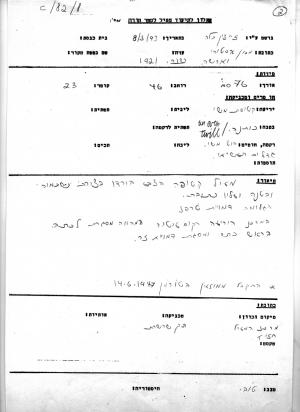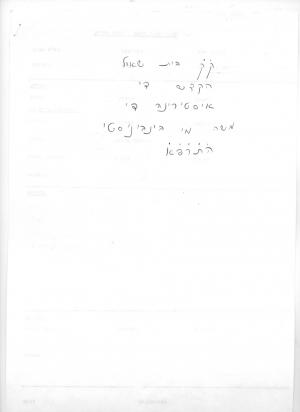Obj. ID: 10858
Sacred and Ritual Objects Torah mantle, Thessaloniki (Salonika), 1921

The trapezoid Torah mantle comprises a cloak attached to a round top, and a vertical back opening.
It is decorated on its upper front face with a crown, flanked by two Stars of David. Below the crown is a Judeo Spanish (Ladino) dedicatory inscription embroidered in square filled letters, which reads:
"ק"ק (קהל קדוש) בית שאול/ הקדש די/ איסטירינה די/ משה מ' בינביניסטי התרפא (=5681)."
"(Dedicated to) The Beit Saul Holy Congregation (Remarks: no. 1). Made by Istrinah (wife of) Moses M. Benvenisti. The year 5681 (1921)."
Below the inscription is a wreath of two flowering stems with leaves bound by a ribbon.
The round top has two openings for the Torah staves. A fringed strip surrounds the top and bottom edges of the cloak.
Online collection of the ritual objects from the E. Ringelblum Jewish Historical Institute is available here: http://cbj.jhi.pl/collections/964689
Summary and Remarks
A collection of ritual objects was confiscated from the Greek Jews when they were transported to Auschwitz during World War II. In 1949, this Torah mantle was handed to the museum from Torun, a city in northern Poland, where the Nazis had concentrated the ritual objects from different places, mainly from Poland.
Remarks
sub-set tree:
Name/Title
Torah mantle | *Synagogue Objects | Torah mantle
Object
Object Detail
Monument Setting
Unknown
Date
1921
Synagogue active dates
Reconstruction dates
Artist/ Maker
Unknown
Origin
Historical Origin
Unknown
Community type
Congregation
Location
Unknown |
Site
Unknown
School/Style
Period
Unknown
Period Detail
Collection
Documentation / Research project
Unknown
Textual Content
Unknown |
Languages of inscription
Unknown
Shape / Form
Unknown
Material / Technique
Material Stucture
Material Decoration
Material Bonding
Material Inscription
Material Additions
Material Cloth
Material Lining
Tesserae Arrangement
Density
Colors
Construction material
Measurements
Height
Length
Width
Depth
Circumference
Thickness
Diameter
Weight
Axis
Panel Measurements
Condition
Extant
Documented by CJA
Surveyed by CJA
Present Usage
Present Usage Details
Condition of Building Fabric
Architectural Significance type
Historical significance: Event/Period
Historical significance: Collective Memory/Folklore
Historical significance: Person
Architectural Significance: Style
Architectural Significance: Artistic Decoration
Urban significance
Significance Rating
0
Ornamentation
Custom
Contents
Codicology
Scribes
Script
Number of Lines
Ruling
Pricking
Quires
Catchwords
Hebrew Numeration
Blank Leaves
Direction/Location
Façade (main)
Endivances
Location of Torah Ark
Location of Apse
Location of Niche
Location of Reader's Desk
Location of Platform
Temp: Architecture Axis
Arrangement of Seats
Location of Women's Section
Direction Prayer
Direction Toward Jerusalem
Coin
Coin Series
Coin Ruler
Coin Year
Denomination
Signature
Colophon
Scribal Notes
Watermark
Hallmark
Group
Group
Group
Group
Group
Trade Mark
Binding
Decoration Program
Suggested Reconsdivuction
History/Provenance
Main Surveys & Excavations
Sources
Type
Documenter
|
Author of description
|
Architectural Drawings
|
Computer Reconstruction
|
Section Head
|
Language Editor
|
Donor
|
Object Copyright
The Emanuel Ringelblum Jewish Historical Institute in Warsaw (JHI)
Negative/Photo. No.
The following information on this monument will be completed:
Unknown |








